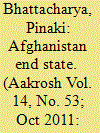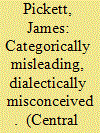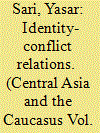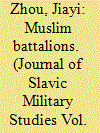|
|
|
Sort Order |
|
|
|
Items / Page
|
|
|
|
|
|
|
| Srl | Item |
| 1 |
ID:
109542


|
|
|
| 2 |
ID:
156108


|
|
|
|
|
| Summary/Abstract |
Persian language manuals uniformly adopt national categories such as Persian/Farsi (Iran), Dari (Afghanistan) and Tajik (Tajikistan). These categories at once impose an imagined contrast between the languages at the high register that is in fact marginal, while occluding profound linguistic variation within these nation-states at colloquial registers. Similar schemas apply to Central Asian Turkic languages such as Uyghur and Uzbek, which are closely related at the formal/literary register, but regionally diverse at lower registers. This dominant instructional approach ill prepares language learners for engaging the region on its own terms, rather than through the lens of nationalist aspirations. Students would be better served by an integrative method that teaches a transnational high language (in the case of Persian) while introducing a diverse range of dialects.
|
|
|
|
|
|
|
|
|
|
|
|
|
|
|
|
| 3 |
ID:
127593


|
|
|
|
|
| Publication |
2013.
|
| Summary/Abstract |
This study aims to describe and explain the relations between identity and conflict by drawing on different theoretical approaches in political science. It examines the questions of whether collective identity, either on a national, civilizational, religious, or social level, is an important variable in trying to understand current conflicts, as well as the prospects for formulating identity-based approaches to conflict. In other words, is it even possible to think about collective identity and conflict simultaneously? This gives rise to another question: Why is collective identity an important factor for explaining the conflict in the Ferghana Valley?
The Ferghana Valley has played a role both in establishing stability in Central Asia and in becoming the starting point of violent conflict throughout the history of the region. The valley became administrationally and ethnically divided into several parts during the Soviet and post-Soviet era. Currently, the tension among the different ethnic, social, and political groups is high because of overpopulation, the increasing scarcity of water and arable land, and the economic hardships and social differentiation that occurred during the political, economic, and social transformation after the Soviet Union collapsed. The Ferghana Valley, at the heart of Central Asia, has become one of the most conflict-prone areas in Central Asia. For these reasons, the valley is a good area for testing the explanatory power of different approaches of political science to explain identity-conflict relations.
Ethnic issues are still extremely important for understanding much of the tension arising in the valley. Not only is there division among the Kyrgyz, Uzbek, and Tajik people, the issue is further complicated by the hostility between different identity-groups and minorities in the region. Additional pressure is arising due to the fact that not only does this tension exist inside each state, it could also escalate to the interstate level.
|
|
|
|
|
|
|
|
|
|
|
|
|
|
|
|
| 4 |
ID:
118667


|
|
|
|
|
| Publication |
2012.
|
| Summary/Abstract |
This article concerns the Soviet military's use of soldiers of Afghan ethnicities (Uzbek, Tajik, Turkmen, and others) during its war in Afghanistan, both as spetsnaz and more generally in the 40th army. Special Forces Detachment 154 and Special Forces Detachment 177, the first and second 'Muslim Battalions,' would play important roles not only during the palace takeover in December 1979 but also during the 1983 cease-fire in Panjshir. This article challenges earlier views that Soviet Muslims and Central Asians were unreliable soldiers who colluded with mujahedin, and points to a more balanced perspective of their role in Afghanistan.
|
|
|
|
|
|
|
|
|
|
|
|
|
|
|
|
|
|
|
|
|